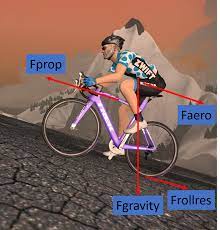I think you’re searching that What are Three Forces You Exert When Riding a Bicycle?
Well!
You’re on right place because you already have worked hard for you. A bike is a simple machine, yet it’s a very complex machine.
For a cyclist, a bike can be a source of pleasure, a means of transportation, a hobby, and an investment. It can also be a source of anxiety, frustration, and pain. So how do you ride a bike?
Gravity: The force of attraction that pulls you down when you are on bicycle
The force of gravity is a universal law. It’s been with us since the beginning of time. It’s what keeps the earth from flying apart. It’s also the reason why astronauts can’t float in space.
In a way, gravity is the most important force of nature. It’s the force that causes things to fall. And it’s the force that makes the moon orbit the earth.
But gravity isn’t always a bad thing. It’s what holds us to the ground and gives us the ability to stand up and walk.
Gravity is the force that makes the earth go round. It’s the force that keeps the sun from burning up. And it’s the force that causes all of the planets to circle the sun.
Gravity is the force that makes us move. It’s the force that keeps us from floating away. It’s the force that pulls us down when we’re on a bicycle.
Air resistance: The force that pushes back on you when you are on bicycle
The force of air resistance is equal to your weight times the square of your velocity. For example, if you weigh 150 lbs and ride at a speed of 20 mph, your resistance will be 15,000 lbs (150 lbs x 20,000 = 15,000 lbs).
When you’re moving at a constant speed, like when you’re driving on a highway, the air resistance doesn’t matter.
But, when you’re moving at variable speeds, like when you’re riding a bike, the air resistance becomes an important factor.
The more resistance you encounter, the harder it is to maintain your speed. If you ride a bicycle on a flat, paved road, the air resistance is very low.
You won’t have much trouble keeping your speed. But, if you ride a bicycle on a hilly, unpaved road, the air resistance is much higher. You’ll have to work harder to maintain your speed.
If you’re going downhill, the air resistance will be lower than if you’re going uphill. So, if you’re on a bicycle, it’s best to ride downhill because the air resistance is less.
But, if you’re on a motorcycle, you’ll have to ride uphill to avoid the air resistance.
The force of the pedals: The force that propels you forward
The force of the pedal is the force that propels you forward when you are on a bicycle. The force of the pedal is created by the force of your foot pushing down on the pedal.
When you push down on the pedal, the force of your foot pushes down on the pedal, which causes the pedal to rotate.
As the pedal rotates, the chain that connects the pedal to the rear wheel of the bike rotates. This causes the rear wheel to turn and propel you forward.
The force of the pedal is created by the force of your foot pushing down on the pedal.
The force of the pedal is the force that propels you forward when you are on a bicycle.
The force of the pedal is created by the force of your foot pushing down on the pedal.
When you push down on the pedal, the force of your foot pushes down on the pedal, which causes the pedal to rotate.
As the pedal rotates, the chain that connects the pedal to the rear wheel of the bike rotates.
This causes the rear wheel to turn and propel you forward.
Conclusion – What are Three Forces You Exert When Riding a Bicycle?
To keep your balance, you need to maintain a constant rate of force with your body. When you are falling off a bicycle, the forces of gravity and inertia are acting on you.
You can use the forces of gravity and inertia to your advantage. For example, if you are falling over, you can use your momentum to push off with your feet, which will help you regain your balance.
To ride a bicycle, you need to maintain a constant rate of force with your body. If you apply too much force to the handlebars, your bike will accelerate. If you apply too little force to the handlebars, your bike will decelerate.
You need to maintain a constant rate of force with your body so that your bicycle doesn’t fall over. If you are falling off a bicycle, the forces of gravity and inertia are acting on you.

